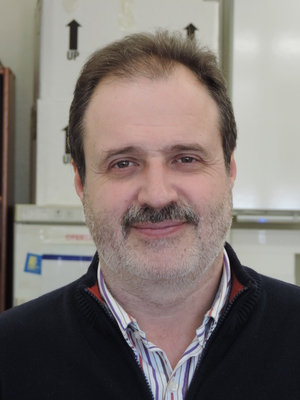
| BALTASAR ESCRICHE SOLER | |
|---|---|
| baltasar.escriche(a)uv.es | |
| Professional category | CATEDRÁTICO DE UNIVERSIDAD |
| Department | UNIV. INSTITUTE BIOTECHNOLOGY AND BIOMEDICINE (BIOTECMED) |
| Phone number | 963543401 |
Journal Publications
Currricul@'s texts
2. Crava CM; Farinós GP; Bel Y; Castañera P; Escriche B. (2013). Quantitative genetic analysis of Cry1Ab tolerance in Ostrinia nubilalis. Journal of Invertebrate Pathology 113: 220 - 227.
3. Hernández-Rodríguez CS; Hernández-Martínez P; Van Rie J; Escriche B; Ferré J. (2013). Shared midgut binding sites for Cry1A.105, Cry1Aa, Cry1Ab, Cry1Ac and Cry1Fa proteins from Bacillus thuringiensis in two important corn pests, Ostrinia nubilalis and Spodoptera frugiperda. PLoS One 8: e68164.
4. Hernández-Rodríguez CS; Hernández-Martínez P; Van Rie J; Escriche B; Ferré J. (2013). Specific binding of radiolabeled Cry1Fa insecticidal protein from Bacillus thuringiensis to midgut sites in lepidopteran species. Applied and Environmental Microbiology. 78: 4048 - 4050.
5. Bel Y; Ferré J; Escriche B. (2011). Quantitative real-time PCR with SYBR Green detection to assess gene duplication in insects: study of gene dosage in Drosophila melanogaster (Diptera) and in Ostrinia nubilalis (Lepidoptera). BMC Research Notes. 4: 1 - 8.
6. Crava CM; Bel Y; Lee SF; Manachini B; Heckel DG; Escriche B. (2010) Study of the aminopeptidase N gene family in the lepidopterans Ostrinia nubilalis (Hübner) and Bombyx mori (L.): Sequences, mapping and expression. Insect Biochemistry and Molecular Biology. 40: 506 - 515.
7. Hernández-Martínez P; Ferré J; Escriche B. (2009) Broad-spectrum cross-resistance in Spodoptera exigua from selection with a marginally toxic Cry protein. Pest Management Science. 65: 645 - 650.
8. Y. Bel; H.A.A. Siqueira; B.D. Siegfried; J. Ferré; B. Escriche. (2009) Variability in the cadherin gene in an Ostrinia nubilalis strain selected for Cry1Ab resistance. Insect Biochemistry and Molecular Biology. 39: 218 - 223.
9. Ibiza-Palacios; M.S.; J. Ferré; S. Higurashi; K. Miyamoto; R. Sato; B. Escriche. (2008) Selective inhibition of binding of Bacillus thuringiensis Cry1Ab toxin to cadherin-like and aminopeptidase proteins in brush border membranes and dissociated epithelial cells from Bombyx mori. Biochemical Journal. 409: 215 - 221. (Reino Unido)
Entidad de realización: Universitat de València
Investigador/es responsable/es: Baltasar Escriche. Número de investigadores/as: 1
Entidad/es financiadora/s: Dow AgroSciences LLC Cód. según financiadora: AGI4282 RSM/nlc. Duración: 2012-2015. Cuantía total: 350.000
2 Caracterización de los receptores de membrana responsables de la toxicidad de las proteínas Cry1F, Cry2A y Vip3A de Bacillus thuringiensis
Entidad de realización: Universitat de València
Investigador responsable: Juan Ferre Manzanero. Número de investigadores/as: 5
Entidad/es financiadora/s: Generalitat Valenciana. Conselleria d'Educació i Ciència. Cód. según financiadora: PROMETEO/2011/044 Duración: 2011-2014. Cuantía total: 165.680
3 Modo de acción de proteínas insecticidas secretables de Bacillus thuringiensis.
Entidad de realización: Universitat de València
Investigador responsable: Juan Ferre Manzanero. Número de investigadores/as: 4
Entidad/es financiadora/s: Ministerio de Ciencia e Innovación. Cód. según financiadora: AGL2009-13340-C02-01. Duración: 2010-2013. Cuantía total: 268.620
4 Sweetpotato Action for Security and Health in Africa (SASHA)
Entidad de realización: Universitat de València
Investigador responsable: Baltasar Escriche Soler. Número de investigadores/as: 2
Entidad/es financiadora/s: Bill and Melinda Gates Foundation (BMGF). Duración: 2009-2014. Cuantía total: 500.000
5 Resistance to African sweetpotato weevils using biotechnology.
Entidad de realización: Universitat de València
Investigador responsable: Baltasar Escriche Soler. Número de investigadores/as: 2
Entidad/es financiadora/s: The Rockefeller Foundation. Cód. según financiadora: 08-EPP-368722-UV. Duración: 2007-2008. Cuantía total: 22.000
6 Specific binding of Bt toxins to midgut membranes from sweetpotato weevil, Cylas spp.
Entidad de realización: Universitat de València
Investigador responsable: Baltasar Escriche Soler. Número de investigadores/as: 2
Entidad/es financiadora/s: The Rockefeller Foundation. Duración: 2006. Cuantía total: 9.600
Baltasar Escriche is the Director of the Master in Research in Molecular and Cellular Biology, and Genetics and Secretary of the Doctoral Program in Biomedicine and Biotechnology at the University of Valencia and belongs to the BTLab team from the research group of Biotechnological Control of Pests (CBP), http://www.cbp.com.es/. He has a positive evaluation of 5 sexennial research periods and the single transference called sexennial period. Google Scholar provides for him 3504 citations, with 32 value for the h-index and 53 value for the i-index.
Several aspects of Bacillus thuringiensis have been studied, with a continuous interest in discovering new bioactive proteins and improving the characterization of the already identified. New agents are essential to be prepared for resistance and to broaden the bioagents application. The main part of the research has been focused on Lepidoptera, because of the most common activity of Bt pesticidal proteins, but research with Coleoptera has been also implemented. Understanding the mode of action of each Bt protein, conventional and new proteins, is the key to its optimal use and preventing the selection of resistant populations. He has spent more than 30 years on this purpose, and still, each day, is finding surprising aspects. He contributed to more than 80 publications mostly in open access and 150 meeting presentations that can exemplify some of these aspects. He has participated in or led over 60 projects. In fact, in the last 5 years, he has participated mostly as PI in 14 projects PI, funded by different sources, including different national and international public institutions, and research agreements with both national and multinational companies. Along this time, it has built a long body of resources, protocols, and collaborations. The problems and science are always global under some point of view, and he has been collaborating with laboratories from the whole world, including ones from the developing countries, such as in Latin America or Africa. Funds obtained from The Rockefeller Foundation, Melinda and Bill Gates Foundation, EU PRIMA program, and specific national programs to collaborate with undeveloped countries are proofs of such vocation. His involvement in the crop protection field led him to become a member of 5 scientific societies, with the special relevance of the Society for Invertebrate Pathology (SIP), where served as Secretary/Treasurer and later as President of the Bacteria Division.
Moreover, he is interested in the dissemination of the research and was co-organizer of the meetings of the SIP/IOBC societies and the one from the Spanish Society of Applied Entomology which took place in Valencia. He actively collaborates with bulletins of such societies not only the international ones but also in the national ones and provides some papers in regular journals of the agricultural sector. The implication with the international companies is evidenced by the contacts but, in addition, he has collaborations with national companies (AFRASA, S.A., PROBELTE, S.A.,¿). The contracts were to develop new materials and technology, but in other cases to offer services not present in the market. Another aspect is the technician formation in different methodologies not only by hiring in funded projects but also with tutoring in the laboratory students from regulated technical studies (Professional Formation) and taking part in specific formation actions.
He has been involved in different facets in the formation of young researches as part of his activities as a university professor, with the remarkably tutoring of 3 or 4 research works per year as Ungraduated and Master Thesis. In addition, he has participated in the evaluation commission of about 10 student research works per year from different levels: undergraduate, Master, Ph.D., but also to evaluate university professor positions. The experience allows some of them to follow in science. The doctorate students tutored by him, including several foreign researchers, obtained a high score in their Thesis and all of them have followed research careers in public and private companies or institutions.
He is a senior piece of the CBP group that has been built over decades and contributes to keeping and enlarging it. The research line of discovering new pesticide resources and the work on insect resistance has been nationally and internationally validated. In fact, he has reviewed projects from several autonomic, national, and international research agencies. It is remarkable the collaboration with the DFG (Germany), ARIS (Slovenia), and DLR (Western Balkan) agencies. Moreover, he has been invited to serve as a reviewer of more than 25 journals and has become a member sequentially to the editorial board of 5 journals. Moreover, he has participated as an invited editor for Special Issues related to B. thuringiensis in different journals.
